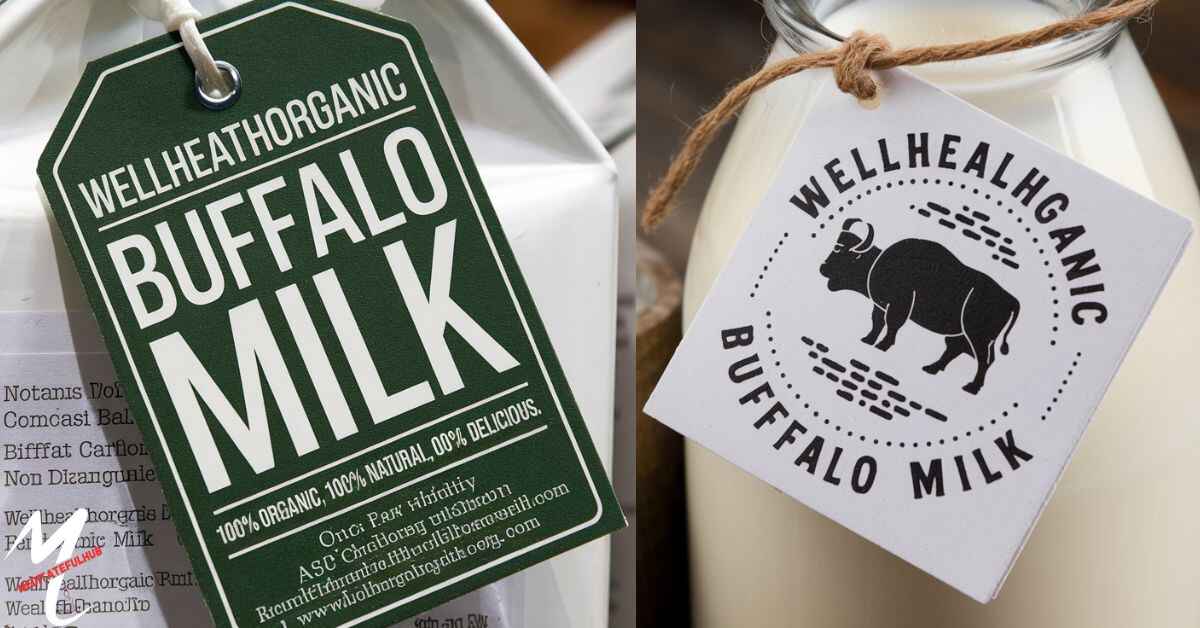Buffalo milk has been consumed for centuries in various cultures due to its rich nutritional profile and creamy texture. It is often compared to cow’s milk, but buffalo milk stands out in several key areas, offering unique health benefits. The Wellhealthorganic buffalo milk tag emphasizes the importance of this dairy product and the various ways it can contribute to a healthy lifestyle. This article explores everything you need to know about buffalo milk, including its nutritional benefits, uses, and impact on health.
Introduction to Buffalo Milk
Buffalo milk is a common dairy product derived from domesticated water buffaloes. While cow’s milk is more popular worldwide, buffalo milk is highly favored in regions like South Asia, Italy, and Egypt due to its rich taste and health benefits. Buffalo milk is known for its thick texture and high-fat content, which makes it an excellent base for producing dairy products like butter, cheese, and yogurt.
Nutritional Composition of Buffalo Milk

Buffalo milk is packed with essential nutrients. It contains higher levels of fat, protein, calcium, and phosphorus compared to cow’s milk, making it highly nutritious. A single glass of buffalo milk can provide a significant portion of the daily recommended intake of various vitamins and minerals.
Some of the key nutritional components of buffalo milk include:
- Fat: Approximately 6-8%, which is significantly higher than cow’s milk.
- Protein: Contains 4.5% protein, essential for muscle repair and growth.
- Calcium: Rich in calcium, beneficial for bone health.
- Vitamins: Vitamins A, B2 (Riboflavin), and C are present in higher quantities.
- Minerals: Contains important minerals like phosphorus, magnesium, and potassium.
The Organic Nature of Buffalo Milk
Buffalo milk, particularly when sourced from organic farms, offers a pure and healthier alternative to conventional dairy products. The wellhealthorganic buffalo milk tag highlights the importance of choosing organic milk to avoid exposure to synthetic hormones, pesticides, and antibiotics that are often used in non-organic dairy farming. Organic farming practices ensure that buffaloes are raised in a more natural environment, free from harmful chemicals, leading to a cleaner and more nutritious milk product. This makes organic buffalo milk a preferred choice for health-conscious individuals who prioritize consuming high-quality, untainted dairy products.
Health Benefits of Buffalo Milk
The wellhealthorganic buffalo milk tag emphasizes the numerous health benefits associated with buffalo milk consumption. Its rich composition of nutrients makes it beneficial for various aspects of health.
Strengthens Bones
Buffalo milk is an excellent source of calcium, which plays a crucial role in maintaining strong bones and teeth. Regular consumption can help prevent conditions like osteoporosis, particularly in older adults and women post-menopause.
Boosts Immune System
Buffalo milk contains high levels of antioxidants such as vitamins A and C, which help boost the immune system. These vitamins play a role in protecting the body from infections and diseases.
Provides Energy
Due to its high fat content, buffalo milk is an excellent source of energy. The fat in buffalo milk is a dense energy source, making it a perfect drink for people with high energy demands such as athletes or individuals recovering from illness.
Improves Cardiovascular Health
While buffalo milk contains a higher fat content, it is mostly unsaturated fat, which is beneficial for heart health. It also contains potassium, a mineral known for regulating blood pressure and promoting cardiovascular function.
Supports Muscle Growth and Repair
With higher protein levels compared to cow’s milk, buffalo milk provides essential amino acids needed for muscle growth and tissue repair. This makes it particularly beneficial for bodybuilders, athletes, or those recovering from injuries.
Buffalo Milk vs. Cow’s Milk: Key Differences

Buffalo milk is often compared to cow’s milk, and while they are both nutritious, there are notable differences between the two:
Fat Content
Buffalo milk has nearly double the fat content of cow’s milk, making it richer and creamier. This also means that it is more caloric and provides more energy per serving.
Protein Content
Buffalo milk contains more protein than cow’s milk, which makes it a better option for those seeking to increase their protein intake.
Lactose Levels
Buffalo milk contains less lactose than cow’s milk, making it easier to digest for individuals with lactose intolerance. However, it is still not lactose-free.
Shelf Life
Buffalo milk has a longer shelf life due to its higher peroxidase activity. This means it spoils less quickly than cow’s milk and can be stored for longer periods without refrigeration.
Culinary Uses of Buffalo Milk
Buffalo milk is used extensively in cooking due to its creamy texture and rich flavor. Some of the common uses include:
Dairy Products
Buffalo milk is the primary ingredient in several popular dairy products:
- Buffalo Mozzarella: A soft, fresh cheese traditionally made from buffalo milk.
- Ghee: Clarified butter made from buffalo milk, widely used in South Asian cooking.
- Paneer: An Indian cheese made from buffalo milk, used in various savory dishes.
Desserts
Buffalo milk is often used to make creamy desserts like ice cream, custards, and puddings. Its high-fat content gives these desserts a richer taste and texture compared to cow’s milk.
Beverages
Buffalo milk is used to make milk-based beverages such as milkshakes, smoothies, and traditional drinks like lassi in India.
Buffalo Milk and Lactose Intolerance
While buffalo milk contains less lactose than cow’s milk, it may still cause discomfort for people who are lactose intolerant. However, some individuals find buffalo milk easier to digest than cow’s milk, as it contains different proteins. If you are lactose intolerant, it is best to consult with a healthcare provider before consuming buffalo milk.
Buffalo Milk for Babies: Is it Safe?

Many parents wonder if buffalo milk is safe for babies. While buffalo milk is nutritious, it is not recommended for infants under one year of age due to its high fat and protein content, which can be difficult for a baby’s digestive system to process. Pediatricians generally recommend breastfeeding or infant formula as the primary source of nutrition for babies under 12 months.
Weight Management and Buffalo Milk
Buffalo milk can be part of a balanced diet for weight management, but it should be consumed in moderation due to its high-calorie content. For those looking to gain weight or increase their energy intake, buffalo milk can be a helpful addition. However, for individuals aiming to lose weight, low-fat options or reduced consumption may be preferable.
Buffalo Milk and Skin Health
Buffalo milk is rich in vitamins A and E, which are known for promoting healthy skin. It is often used in natural skincare remedies, including:
- Buffalo Milk Face Masks: The fat and vitamins in buffalo milk can hydrate and nourish the skin when applied topically.
- Buffalo Milk Bath: Some people add buffalo milk to their bathwater to soften and rejuvenate the skin.
Buffalo Milk and Diabetes
The wellhealthorganic buffalo milk tag highlights the potential benefits of buffalo milk for people with diabetes. While buffalo milk contains natural sugars, its lower lactose content and higher fat and protein levels can slow the absorption of sugars, leading to more stable blood sugar levels. However, individuals with diabetes should monitor their milk consumption and consult their healthcare provider for personalized advice.
How to Include Buffalo Milk in Your Diet
Buffalo milk can be easily incorporated into your daily diet. You can use it in place of cow’s milk in almost any recipe. Here are a few ideas:
- Breakfast: Use buffalo milk in smoothies, coffee, or oatmeal.
- Cooking: Substitute buffalo milk for cow’s milk in soups, sauces, and baked goods.
- Snacking: Enjoy buffalo milk yogurt or cheese with fruits or crackers.
Weight Management Considerations
While buffalo milk is a nutritious and energy-dense option, its high fat and calorie content may not be suitable for everyone, especially those focused on weight management or individuals with conditions such as high cholesterol. For individuals on a weight loss journey or those who need to monitor their fat intake, consuming buffalo milk in moderation is crucial. Low-fat or reduced-fat versions of buffalo milk can still offer many of the nutritional benefits without the excessive fat content, making it a more balanced option for those concerned about their calorie consumption.
Sustainability and Environmental Impact of Buffalo Farming
The wellhealthorganic buffalo milk tag also draws attention to the environmental considerations of buffalo farming. Compared to cows, buffaloes require more water and feed, which can increase the environmental footprint of buffalo milk production. However, by supporting organic farms that implement sustainable and eco-friendly practices, consumers can help mitigate this impact. Organic buffalo farming often focuses on reducing waste, conserving water, and avoiding harmful agricultural chemicals, contributing to a more sustainable dairy industry. By choosing organic buffalo milk, consumers not only benefit from a healthier product but also contribute to reducing the environmental strain of dairy farming.
Incorporating Buffalo Milk Into a Balanced Diet
Buffalo milk is versatile and can be incorporated into a variety of dishes and recipes, making it easy to add to a balanced diet. Whether consumed on its own, used in smoothies, or included in baking and cooking, buffalo milk provides a creamy and nutrient-rich base for a wide range of culinary creations. It can be used as a substitute for cow’s milk in most recipes, enhancing the flavor and texture of dishes. Buffalo milk is especially popular in making dairy products like cheese, yogurt, and ghee, which are staples in many cuisines around the world. These products not only taste richer but also carry the nutritional benefits of buffalo milk.

Potential Risks of Buffalo Milk
Although buffalo milk is nutritious, it may not be suitable for everyone. Some potential risks include:
- High Fat Content: People with high cholesterol or cardiovascular issues should be mindful of buffalo milk’s fat content.
- Lactose Sensitivity: Those with lactose intolerance may experience digestive discomfort, though some find it easier to digest than cow’s milk.
- Allergies: Individuals allergic to dairy proteins should avoid buffalo milk.
How to Source Organic Buffalo Milk
The wellhealthorganic buffalo milk tag emphasizes the importance of organic sourcing. Organic buffalo milk comes from buffaloes that are raised without the use of synthetic hormones, antibiotics, or pesticides. This ensures a purer and healthier milk product. To source organic buffalo milk, look for local dairy farms that practice sustainable farming or purchase from certified organic brands.
Environmental Impact of Buffalo Milk Production
Buffalo farming, like all animal farming, has an environmental impact. Buffaloes require more water and feed compared to cows, and their methane emissions contribute to greenhouse gases. However, organic and sustainable buffalo farming practices can reduce this impact. Supporting eco-friendly and local farms can help minimize the environmental footprint of buffalo milk production.
Conclusion
Buffalo milk is a highly nutritious and versatile dairy product that offers a wealth of health benefits. Whether you are looking to increase your protein intake, improve bone health, or enjoy a richer dairy product in your cooking, buffalo milk is an excellent option. However, its high fat content and lactose levels mean it may not be suitable for everyone. Consult with a healthcare provider to determine if buffalo milk is a good fit for your diet.
The wellhealthorganic buffalo milk tag encourages consumers to explore buffalo milk as a nutritious alternative to cow’s milk, emphasizing organic and sustainable sourcing for the best health and environmental outcomes.
Read More: Colin Cowherd Net Worth Overview in 2024









